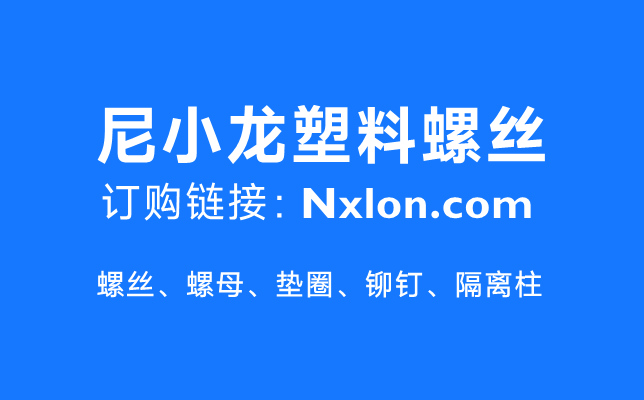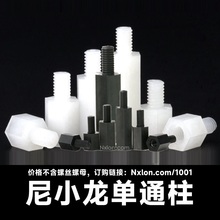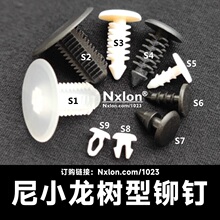Semi-countersunk Head Rivet
©Nxlon.com D/T:

The semi-countersunk head rivet is a type of rivet. It has some similarities with the countersunk head rivet in terms of structural features, material selection, manufacturing process, etc., but it also has some of its own characteristics:
Structural Features of the Semi-countersunk Head Rivet
Head Shape: The head of the semi-countersunk head rivet is in the shape of a truncated cone, similar to that of the countersunk head rivet. However, the conical surface angle of the head of the semi-countersunk head rivet is usually gentler, and there is a smaller flat surface at the top of the head. This design makes it so that after the rivet is installed, the head will not be completely flush with the surface of the connected part. Instead, a part of it will protrude slightly, forming a shape similar to a mushroom head, but the protruding part is relatively small. It can still maintain the smoothness of the surface to a certain extent, and at the same time, it can provide a certain degree of decorativeness or facilitate the disassembly operation.
Shank Structure: Similar to the countersunk head rivet, it usually has a solid cylindrical shank to ensure that the rivet has sufficient strength and rigidity to withstand the tensile and shear forces during the connection process, and to achieve a reliable connection between the connected parts.
Material Selection of the Semi-countersunk Head Rivet
The commonly used materials for semi-countersunk head rivets are similar to those for countersunk head rivets, mainly including the following types:
Carbon Steel: It has high strength and hardness and can bear large loads. It is suitable for occasions with high requirements for connection strength in the general industrial field, such as machinery manufacturing, building structures, etc. Its cost is relatively low, and it has a high cost-performance ratio.
Stainless Steel: It has excellent corrosion resistance and oxidation resistance and is suitable for harsh environments, such as humid outdoor environments, chemical production workshops, etc. It can ensure that the rivet will not be corroded during long-term use and maintain good connection performance. It is often used in equipment and structures with high requirements for corrosion resistance.
Aluminum Alloy: It is light in weight and has a certain degree of corrosion resistance. It is often used in fields that are sensitive to weight, such as aerospace, electronic equipment manufacturing, etc. While ensuring the connection strength, it helps to reduce the overall structural weight and improve the performance and portability of the product.
Manufacturing Process of the Semi-countersunk Head Rivet
Forging: First, heat the metal material to an appropriate temperature, and then process it into the approximate shape of the rivet through the forging process, including the preliminary forming of the head and the shank. Forging can refine the internal grains of the metal material, make the structure dense, and improve the strength and toughness of the rivet.
Machining: Carry out precise machining on the forged rivet to ensure dimensional accuracy. Carry out fine processing on the shape and size of the head to make it meet the design requirements, and carry out precise cutting on the length and diameter of the shank to ensure that all dimensions of the rivet meet the relevant standards. At the same time, carry out surface grinding and polishing treatment to reduce surface roughness and improve surface quality, so that the rivet can fit better with the connected part after installation.
Heat Treatment: For some semi-countersunk head rivets with high performance requirements, heat treatment processes such as quenching and tempering will be carried out to further improve the mechanical properties of the rivet, such as hardness, strength, and wear resistance, to meet the usage requirements under different working conditions.
Application Fields of the Semi-countersunk Head Rivet
Aerospace: Semi-countersunk head rivets are used in some non-critical parts of the aircraft or in places where the requirements for aerodynamic performance are not extremely high but a certain connection strength and appearance requirements are needed. For example, in the connection of some internal structural parts, it can not only ensure the reliability of the connection but also save weight to a certain extent. At the same time, the semi-countersunk head design also facilitates the disassembly operation during maintenance.
Automobile Manufacturing: It can be used for the connection of some internal components of the automobile body, such as the fixing of interior parts, the connection of part of the vehicle frame structure, etc. The semi-countersunk head appearance can not only ensure a certain degree of aesthetics but also provide convenience when disassembly and maintenance are required. Moreover, the connection strength is sufficient to withstand the vibrations and various forces during the driving process of the automobile.
Electronic Equipment: In the manufacturing of the casings of some electronic equipment, semi-countersunk head rivets are used when a certain degree of decorativeness or convenience for later disassembly and maintenance is required. For example, for the casings of some high-end audio equipment, server chassis, etc., the semi-countersunk head rivets can, while ensuring a firm connection, make the appearance of the equipment more exquisite and facilitate opening the casing for inspection or upgrading when needed.
Furniture Manufacturing: In furniture manufacturing, semi-countersunk head rivets can be used to connect wooden or metal parts. Especially in the design of some furniture with a modern and simple style, the slightly protruding head of the semi-countersunk head rivet can be used as a decorative element to increase the uniqueness and fashion sense of the furniture, and at the same time, it provides sufficient connection strength to ensure the structural stability of the furniture.
Marking Method of the Semi-countersunk Head Rivet
The marking of the semi-countersunk head rivet usually also includes information such as the product name, nominal diameter, nominal length, material, and surface treatment. For example, the marking "Rivet, Semi-countersunk Head, GB/T xxx - xxxx, 6×30 - Carbon Steel, Galvanized" indicates a semi-countersunk head rivet with a nominal diameter of 6mm, a nominal length of 30mm, a material of carbon steel, and a surface treatment of galvanization. Among them, GB/T xxx - xxxx is the corresponding national standard number, and different types and specifications of semi-countersunk head rivets should be marked in accordance with the corresponding standards for easy identification and selection.
Installation Precautions of the Semi-countersunk Head Rivet
Aperture and Hole Depth: During installation, the diameter of the installation hole on the connected part should match the nominal diameter of the rivet. Generally, the aperture is slightly larger than the diameter of the shank of the rivet to facilitate the insertion of the rivet. The hole depth should be controlled according to the size and design requirements of the rivet head. It is necessary to ensure that the head of the rivet can be partially sunk into the installation hole to achieve the designed semi-countersunk head effect, and it should not be too deep or too shallow to avoid affecting the connection strength and appearance.
Riveting Tools and Pressure: Select appropriate riveting tools according to the material and specifications of the rivet, such as pneumatic riveting machines, hydraulic riveting machines, or manual rivet guns. During the riveting process, the magnitude of the pressure should be precisely controlled. If the pressure is too small, the rivet may not be able to deform sufficiently and will not be closely combined with the connected part; if the pressure is too large, the head of the rivet may be overly deformed or the shank may break, affecting the connection performance and appearance effect.
Verticality and Concentricity: When inserting the rivet into the installation hole, it is necessary to ensure that the axis of the rivet is perpendicular to the surface of the connected part and concentric with the installation hole. This can enable the rivet to be evenly stressed during the riveting process, ensure that the head can form the correct semi-countersunk head shape, and at the same time ensure that the shank is closely matched with the hole wall, improving the strength and stability of the connection.
尼小龙塑料螺丝-塑料螺母-尼龙垫圈-塑料铆钉
塑料螺丝保护套-螺母保护帽
订购链接:Nxlon.com/1035
塑料螺丝帽保护套-塑料螺母保护帽M8M10六角塑料螺母保护帽外六角塑料螺丝盖罩螺栓螺丝装饰防尘套,尼小龙螺母保护帽材质:聚丙烯 Polypropylene,型号:S-12-PP, S-13-PP, S-14-PP, S-16-PP, S-17-PP
尼小龙EHR塑料花瓣型护线套
订购链接:Nxlon.com/1050
塑料梅花型护线套EHR尼龙扣式线束圈花瓣形保护环卡电线出线孔塞材质:尼龙,颜色:黑色、白色;规格:EHR-16、EHR-19、EHR-21、EHR-22、EHR-25等。
绝缘尼龙单通六角隔离柱
订购链接:Nxlon.com/1001
绝缘尼龙单通六角隔离柱:M2.5 M3 M4尼龙单头六角单通柱隔离柱采用先进的立体蜂巢结构全自动化脱模模具工艺高效成型!尼龙柱内螺纹是一次性注塑成型,不易滑牙!
绝缘尼龙十字沉头螺丝
订购链接:Nxlon.com/1017
绝缘尼龙十字沉头螺丝采用知名品牌进口注塑级尼龙PA66、参照国标GB819标准规定的尺寸制造而成。现货沉头塑料螺丝的螺纹规格有:M3*0.5mm、M4*0.7mm等。
R2040-塑料铆钉-尼龙铆钉
订购链接:Nxlon.com/2040
R2040-塑料铆钉-尼龙铆钉塑料铆钉-尼龙铆钉-汽车塑胶铆钉-尼小龙尼龙铆钉R2.6R3.5R4R5塑胶柳钉子母铆钉快捷紧固件塑料卡扣。
塑料铆钉-尼小龙树形铆钉
订购链接:Nxlon.com/1023
绝缘塑料树形铆钉又称倒齿形塑料铆钉或圣诞树型塑料铆钉品名:树型塑料铆钉;材质:尼龙 Nylon;适合孔径:5.5mm-6.5mm;适合板厚:2.0mm-10.0mm
R3055-塑料铆钉-尼龙铆钉
订购链接:Nxlon.com/3055
R3055-塑料铆钉-尼龙铆钉塑料铆钉-尼龙铆钉-汽车塑胶铆钉-尼小龙尼龙铆钉R2.6R3.5R4R5塑胶柳钉子母铆钉快捷紧固件塑料卡扣。









